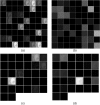Microscopic medical image classification framework via deep learning and shearlet transform
- PMID: 27872871
- PMCID: PMC5093219
- DOI: 10.1117/1.JMI.3.4.044501
Microscopic medical image classification framework via deep learning and shearlet transform
Abstract
Cancer is the second leading cause of death in US after cardiovascular disease. Image-based computer-aided diagnosis can assist physicians to efficiently diagnose cancers in early stages. Existing computer-aided algorithms use hand-crafted features such as wavelet coefficients, co-occurrence matrix features, and recently, histogram of shearlet coefficients for classification of cancerous tissues and cells in images. These hand-crafted features often lack generalizability since every cancerous tissue and cell has a specific texture, structure, and shape. An alternative approach is to use convolutional neural networks (CNNs) to learn the most appropriate feature abstractions directly from the data and handle the limitations of hand-crafted features. A framework for breast cancer detection and prostate Gleason grading using CNN trained on images along with the magnitude and phase of shearlet coefficients is presented. Particularly, we apply shearlet transform on images and extract the magnitude and phase of shearlet coefficients. Then we feed shearlet features along with the original images to our CNN consisting of multiple layers of convolution, max pooling, and fully connected layers. Our experiments show that using the magnitude and phase of shearlet coefficients as extra information to the network can improve the accuracy of detection and generalize better compared to the state-of-the-art methods that rely on hand-crafted features. This study expands the application of deep neural networks into the field of medical image analysis, which is a difficult domain considering the limited medical data available for such analysis.
Keywords: breast cancer; deep neural network; microscopic images; prostate cancer; shearlet transform.
Figures









References
-
- American Cancer Society, Cancer facts and figures, Technical Report (2016).
-
- Demir C., Yener B., “Automated cancer diagnosis based on histopathological images: a systematic survey,” Rensselaer Polytechnic Institute, Technical Report (2005).
-
- Boucheron L. E., Manjunath B. S., Harvey N. R., “Use of imperfectly segmented nuclei in the classification of histopathology images of breast cancer,” in 2010 IEEE Int. Conf. on Acoustics, Speech and Signal Processing, pp. 666–669, IEEE; (2010).10.1109/ICASSP.2010.5495124 - DOI
-
- Farjam R., et al. , “Tree-structured grading of pathological images of prostate,” Proc. SPIE 5747, 840–851 (2005).PSISDG10.1117/12.596068 - DOI
LinkOut - more resources
Full Text Sources
Other Literature Sources

